(AKC Terrier Group)
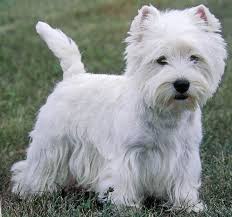 The hardy West Highland White Terrier, more commonly known as the
"Westie," is known for its friendly, strong-willed personality and a
remarkably bright white coat. Said to be "all terrier," this breed
possesses a large amount of spunk, determination and devotion stuffed
into a compact little body. The confident Westie excels in a variety of
AKC events, from conformation to agility to obedience.
The hardy West Highland White Terrier, more commonly known as the
"Westie," is known for its friendly, strong-willed personality and a
remarkably bright white coat. Said to be "all terrier," this breed
possesses a large amount of spunk, determination and devotion stuffed
into a compact little body. The confident Westie excels in a variety of
AKC events, from conformation to agility to obedience.
General Appearance
The West Highland White Terrier is a small, game, well-balanced hardy looking terrier, exhibiting good showmanship, possessed with no small amount of self-esteem, strongly built, deep in chest and back ribs, with a straight back and powerful hindquarters on muscular legs, and exhibiting in marked degree a great combination of strength and activity. The coat is about two inches long, white in color, hard, with plenty of soft undercoat. The dog should be neatly presented, the longer coat on the back and sides, trimmed to blend into the shorter neck and shoulder coat. Considerable hair is left around the head to act as a frame for the face to yield a typical Westie expression.
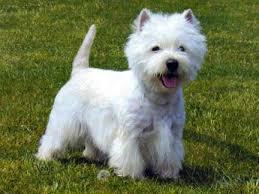 Size, Proportion, Substance
Size, Proportion, Substance
The ideal size is eleven inches at the withers for dogs and ten inches for bitches. A slight deviation is acceptable. The Westie is a compact dog, with good balance and substance. The body between the withers and the root of the tail is slightly shorter than the height at the withers. Short-coupled and well boned. Faults--Over or under height limits. Fine boned.
Head
Shaped to present a round appearance from the front. Should be in proportion to the body. Expression--Piercing, inquisitive, pert. Eyes--Widely set apart, medium in size, almond shaped, dark brown in color, deep set, sharp and intelligent. Looking from under heavy eyebrows, they give a piercing look. Eye rims are black. Faults--Small, full or light colored eyes. Ears--Small, carried tightly erect, set wide apart, on the top outer edge of the skull. They terminate in a sharp point, and must never be cropped. The hair on the ears is trimmed short and is smooth and velvety, free of fringe at the tips. Black skin pigmentation is preferred. Faults--Round-pointed, broad, large, ears set closely together, not held tightly erect, or placed too low on the side of the head. Skull--Broad, slightly longer than the muzzle. not flat on top but slightly domed between the ears. It gradually tapers to the eyes. There is a defined stop, eyebrows are heavy. Faults--Long or narrow skull. Muzzle--Blunt, slightly shorter than the skull, powerful and gradually tapering to the nose, which is large and black. The jaws are level and powerful. Lip pigment is black. Faults--Muzzle longer than skull. Nose color other than black. Bite--The teeth are large for the size of the dog. There must be six incisor teeth between the canines of both lower and upper jaws. An occasional missing premolar is acceptable. A tight scissors bite with upper incisors slightly overlapping the lower incisors or level mouth is equally acceptable. Faults--Teeth defective or misaligned. Any incisors missing or several premolars missing. Teeth overshot or undershot.
Neck
Muscular and well set on sloping shoulders. The length of neck should be in proportion to the remainder of the dog. Faults--Neck too long or too short. Topline--Flat and level, both standing and moving. Faults--High rear, any deviation from above. Body--Compact and of good substance. Ribs Faults--Back weak, either too long or too short. Barrel ribs, ribs above elbows. Tail--Relatively short, with good substance, and shaped like a carrot. When standing erect it is never extended above the top of the skull. It is covered with hard hair without feather, as straight as possible, carried gaily but not curled over the back. The tail is set on high enough so that the spine does not slope down to it. The tail is never docked. Faults--Set too low, long, thin, carried at half-mast, or curled over back.
 deep and well
arched in the upper half of rib, extending at least to the elbows, and presenting
a flattish side appearance. Back ribs of considerable depth, and distance
from last rib to upper thigh as short as compatible with free movement of
the body. Chest very deep and extending to the elbows, with breadth in proportion
to the size of the dog. Loin short, broad and strong.
deep and well
arched in the upper half of rib, extending at least to the elbows, and presenting
a flattish side appearance. Back ribs of considerable depth, and distance
from last rib to upper thigh as short as compatible with free movement of
the body. Chest very deep and extending to the elbows, with breadth in proportion
to the size of the dog. Loin short, broad and strong.
Forequarters
Angulation, Shoulders--Shoulder blades are well laid back and well knit at the backbone. The shoulder blade should attach to an upper arm of moderate length, and sufficient angle to allow for definite body overhang. Faults--Steep or loaded shoulders. Upper arm too short or too straight. Legs--Forelegs are muscular and well boned. relatively short, but with sufficient length to set the dog up so as not to be too close to the ground. The legs are reasonably straight, and thickly covered with short hard hair. They are set in under the shoulder blades with definite body overhang before them. Height from elbow to withers and elbow to ground should be approximately the same. Faults--Out at elbows. Light bone, fiddle-front. Feet--Forefeet are larger than the hind ones, are round, proportionate in size, strong, thickly padded; they may properly be turned out slightly. Dewclaws may be removed. Black pigmentation is most desirable on pads of all feet and nails, although nails may lose coloration in older dogs.
Hindquarters
Angulation--Thighs are very muscular, well angulated, not set wide apart, with hock well bent, short, and parallel when viewed from the rear. Legs--Rear legs are muscular and relatively short and sinewy. Faults-- Weak hocks, long hocks, lack of angulation. Cowhocks. Feet--Hind feet are smaller than front feet, and are thickly padded. Dewclaws may be removed.
Coat
Very important and seldom seen to perfection. Must be double-coated. The head is shaped by plucking the hair, to present the round appearance. The outer coat consists of straight hard white hair, about two inches long, with shorter coat on neck and shoulders, properly blended and trimmed to blend shorter areas into furnishings, which are longer on stomach and legs. The ideal coat is hard, straight and white, but a hard straight coat which may have some wheaten tipping is preferable to a white fluffy or soft coat. Furnishings may be somewhat softer and longer but should never give the appearance of fluff. Faults--Soft coat. Any silkiness or tendency to curl. Any open or single coat, or one which is too short.
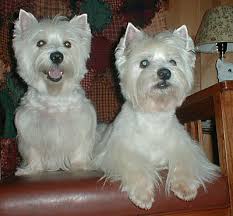 Color
Color
The color is white, as defined by the breed’s name. Faults--Any coat color other than white. Heavy wheaten color.
Gait
Free, straight and easy all around. It is a distinctive gait, not stilted, but powerful, with reach and drive. In front the leg is freely extended forward by the shoulder. When seen from the front the legs do not move square, but tend to move toward the center of gravity. The hind movement is free, strong and fairly close. The hocks are freely flexed and drawn close under the body, so that when moving off the foot the body is thrown or pushed forward with some force. Overall ability to move is usually best evaluated from the side, and topline remains level. Faults--Lack of reach in front, and/or drive behind. Stiff, stilted or too wide movement.
Approved December 13, 1988
Effective February 1, 1989

US owner surveys put the average lifespan of a Westie at 12 to 16 years, and some beyond that; while the average litter size is between three and five puppies.There are breed predispositions to conditions found across many dog breeds, such as abdominal hernias. Westie puppies may be affected by Craniomandibular osteopathy, a disease also known "lion jaw", and is sometimes also referred to as "westie jaw". The disease is an autosomal recessive condition and so a puppy can only be affected by gene. The condition appears across many breeds, including several different types of terrier, as well as other unrelated breeds such as the Great Dane. It typically appears in dogs under a year old, and can cause problems for the dog to chew or swallow food. Radiographic testing can be conducted to diagnose the condition, in which the bones around the jaw thicken; additionally the blood may show increased calcium levels and enzyme levels. The condition often stops progressing by the time the dog is a year old, and in some cases can recede. It is normally treated with anti-inflammatory medications, and the feeding of soft foods. In some cases, tube feeding may be necessary. However, if the animal still cannot eat and is in uncontrolled pain, then euthanasia may be the only medical option remaining.
it if both its parents are carriers of the faulty
The breed is prone to skin disorders. About a quarter of Westies surveyed are affected by atopic dermatitis, a heritable chronic allergic skin condition. A higher proportion of males are affected compared to females. There is an uncommon but severe breed-specific skin condition that may affect West Highland White Terriers affecting both juveniles and adults dogs. This condition is called Hyperplastic Dermatosis. Affected dogs can suffer from red hyperpigmentation, lichenification and hair loss. In the initial stages, this condition can be misdiagnosed as allergies or less serious forms of dermatitis.
An inherited genetic problem that exists in the breed is globoid cell leukodystrophy. It is not breed specific, and can appear in Cairn Terriers and other breeds including Beagles and Pomeranians. It is a neurological disease where the dog lacks an enzyme called galactosylceramidase. The symptoms are noticeable as the puppy develops, and can be identified by the age of 30 weeks. Affected dogs will have tremors, weakness in its muscles and difficulties in walking. Symptoms will slowly increase until limb paralysis begins to occur. Due to it being a hereditary condition, it is recommended for owners to avoid breeding affected animals in order to eliminate it from the breed. Another genetic condition that affects the breed is "White dog shaker syndrome". As this condition is most commonly found in Westies and in Maltese, the condition was originally thought to be connected to the genes for white coats, however the same condition has since been found in other non-white breeds including the Yorkshire Terrier and the Dachshund. The condition typically develops over one to three days resulting in tremors of the head and limbs, ataxia and hypermetria. Affected males and females can be affected for different lengths of time, with symptoms in females lasting for between four to six weeks, while males can be affected the rest of its life.
Other less common conditions which appear in the breed include hydroxyglutaric aciduria, which is where there are elevated levels of alpha-Hydroxyglutaric acid in the dog's urine, blood plasma and spinal fluid. It can cause seizures, muscle stiffness and ataxia, but is more commonly found in Staffordshire Bull Terriers. A degeneration of the hip-joint, known as Legg–Calvé–Perthes syndrome also occurs to the breed. However the chances of this condition occurring are much higher in some other breeds, such as the Australian Shepherd or the Miniature Pincher. The breed is also one of the least likely to be affected by a luxating patella, where the knee cap slips out of place.
 The temperament of the West Highland White
The temperament of the West Highland White
Terrier can vary greatly, with some being friendly towards children whilst others prefer solitude. It will not Members of the breed are normally independent, assured and self confident and can make good watchdogs. Alert, gay, courageous and self-reliant, but friendly. Faults--Excess timidity or excess pugnacity. It is a loyal breed that bonds with its owners, but is often always on the move requiring a fair deal of exercise. Westies are highly social and are the most friendly and jolly of all the Scottish breeds of terrier. They can tolerate rough handling such as a child pulling on its ears, and can be both food and toy possessive. It is a hardy breed, and can be stubborn leading to issues with training. A Westie may need to have its training refreshed on occasion during its lifetime. Having a typical terrier prey drive, it tends to be highly interested in toys especially chasing balls. It does retain the instincts of an earth-dog, including inquisitive and investigative traits, as well as natural instincts to both bark and dig holes. It is ranked 47th in Stanley Coren's The Intelligence of Dogs.
Did You Know?
West Highland Terrier History
The West Highland White Terrier, according to notable authors,
originated at Poltalloch, Scotland, where they had been bred and
maintained for more than 100 years prior to their appearance at dog
shows. In 1916, Colonel Malcolm of Poltalloch said that his father and
grandfather both kept them. It is probable that the lineage of the
Malcolm dogs goes back to the time of King James I, who asked for some
"earth-dogges" out of Argyleshire. Years ago the breed was known as the
Roseneath Terrier, also as the Poltalloch Terrier.
The first show held for the breed was at Crufts in London in 1907. The first AKC registration was in 1908. Originally registered as the Roseneath Terrier, the name was officially changed to West Highland White Terrier on May 31, 1909.
The West Highland is all terrier – a large amount of Scotch spunk, determination, and devotion crammed into a small body. Outdoors they are truly sporty, good hunters, speedy, and cunning, with great intelligence. In the house they are all that can be desired of a pet: faithful, understanding, and devoted, yet gay and lighthearted.
West Highland Terrier Pics

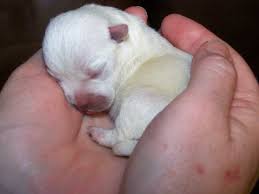
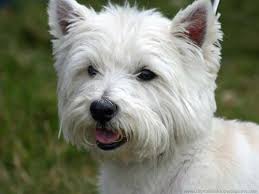
West Highland White Terrier
Parent Club: West Highland White Terrier Club of America
Breeder Directory: website
Regional Clubs: website
West Highland Terrier AKC Breed Standards
General Appearance
The West Highland White Terrier is a small, game, well-balanced hardy looking terrier, exhibiting good showmanship, possessed with no small amount of self-esteem, strongly built, deep in chest and back ribs, with a straight back and powerful hindquarters on muscular legs, and exhibiting in marked degree a great combination of strength and activity. The coat is about two inches long, white in color, hard, with plenty of soft undercoat. The dog should be neatly presented, the longer coat on the back and sides, trimmed to blend into the shorter neck and shoulder coat. Considerable hair is left around the head to act as a frame for the face to yield a typical Westie expression.
The ideal size is eleven inches at the withers for dogs and ten inches for bitches. A slight deviation is acceptable. The Westie is a compact dog, with good balance and substance. The body between the withers and the root of the tail is slightly shorter than the height at the withers. Short-coupled and well boned. Faults--Over or under height limits. Fine boned.
Head
Shaped to present a round appearance from the front. Should be in proportion to the body. Expression--Piercing, inquisitive, pert. Eyes--Widely set apart, medium in size, almond shaped, dark brown in color, deep set, sharp and intelligent. Looking from under heavy eyebrows, they give a piercing look. Eye rims are black. Faults--Small, full or light colored eyes. Ears--Small, carried tightly erect, set wide apart, on the top outer edge of the skull. They terminate in a sharp point, and must never be cropped. The hair on the ears is trimmed short and is smooth and velvety, free of fringe at the tips. Black skin pigmentation is preferred. Faults--Round-pointed, broad, large, ears set closely together, not held tightly erect, or placed too low on the side of the head. Skull--Broad, slightly longer than the muzzle. not flat on top but slightly domed between the ears. It gradually tapers to the eyes. There is a defined stop, eyebrows are heavy. Faults--Long or narrow skull. Muzzle--Blunt, slightly shorter than the skull, powerful and gradually tapering to the nose, which is large and black. The jaws are level and powerful. Lip pigment is black. Faults--Muzzle longer than skull. Nose color other than black. Bite--The teeth are large for the size of the dog. There must be six incisor teeth between the canines of both lower and upper jaws. An occasional missing premolar is acceptable. A tight scissors bite with upper incisors slightly overlapping the lower incisors or level mouth is equally acceptable. Faults--Teeth defective or misaligned. Any incisors missing or several premolars missing. Teeth overshot or undershot.
Neck
Muscular and well set on sloping shoulders. The length of neck should be in proportion to the remainder of the dog. Faults--Neck too long or too short. Topline--Flat and level, both standing and moving. Faults--High rear, any deviation from above. Body--Compact and of good substance. Ribs Faults--Back weak, either too long or too short. Barrel ribs, ribs above elbows. Tail--Relatively short, with good substance, and shaped like a carrot. When standing erect it is never extended above the top of the skull. It is covered with hard hair without feather, as straight as possible, carried gaily but not curled over the back. The tail is set on high enough so that the spine does not slope down to it. The tail is never docked. Faults--Set too low, long, thin, carried at half-mast, or curled over back.
 deep and well
arched in the upper half of rib, extending at least to the elbows, and presenting
a flattish side appearance. Back ribs of considerable depth, and distance
from last rib to upper thigh as short as compatible with free movement of
the body. Chest very deep and extending to the elbows, with breadth in proportion
to the size of the dog. Loin short, broad and strong.
deep and well
arched in the upper half of rib, extending at least to the elbows, and presenting
a flattish side appearance. Back ribs of considerable depth, and distance
from last rib to upper thigh as short as compatible with free movement of
the body. Chest very deep and extending to the elbows, with breadth in proportion
to the size of the dog. Loin short, broad and strong. Forequarters
Angulation, Shoulders--Shoulder blades are well laid back and well knit at the backbone. The shoulder blade should attach to an upper arm of moderate length, and sufficient angle to allow for definite body overhang. Faults--Steep or loaded shoulders. Upper arm too short or too straight. Legs--Forelegs are muscular and well boned. relatively short, but with sufficient length to set the dog up so as not to be too close to the ground. The legs are reasonably straight, and thickly covered with short hard hair. They are set in under the shoulder blades with definite body overhang before them. Height from elbow to withers and elbow to ground should be approximately the same. Faults--Out at elbows. Light bone, fiddle-front. Feet--Forefeet are larger than the hind ones, are round, proportionate in size, strong, thickly padded; they may properly be turned out slightly. Dewclaws may be removed. Black pigmentation is most desirable on pads of all feet and nails, although nails may lose coloration in older dogs.
Hindquarters
Angulation--Thighs are very muscular, well angulated, not set wide apart, with hock well bent, short, and parallel when viewed from the rear. Legs--Rear legs are muscular and relatively short and sinewy. Faults-- Weak hocks, long hocks, lack of angulation. Cowhocks. Feet--Hind feet are smaller than front feet, and are thickly padded. Dewclaws may be removed.
Coat
Very important and seldom seen to perfection. Must be double-coated. The head is shaped by plucking the hair, to present the round appearance. The outer coat consists of straight hard white hair, about two inches long, with shorter coat on neck and shoulders, properly blended and trimmed to blend shorter areas into furnishings, which are longer on stomach and legs. The ideal coat is hard, straight and white, but a hard straight coat which may have some wheaten tipping is preferable to a white fluffy or soft coat. Furnishings may be somewhat softer and longer but should never give the appearance of fluff. Faults--Soft coat. Any silkiness or tendency to curl. Any open or single coat, or one which is too short.
The color is white, as defined by the breed’s name. Faults--Any coat color other than white. Heavy wheaten color.
Gait
Free, straight and easy all around. It is a distinctive gait, not stilted, but powerful, with reach and drive. In front the leg is freely extended forward by the shoulder. When seen from the front the legs do not move square, but tend to move toward the center of gravity. The hind movement is free, strong and fairly close. The hocks are freely flexed and drawn close under the body, so that when moving off the foot the body is thrown or pushed forward with some force. Overall ability to move is usually best evaluated from the side, and topline remains level. Faults--Lack of reach in front, and/or drive behind. Stiff, stilted or too wide movement.
Approved December 13, 1988
Effective February 1, 1989
West Highland Terrier Health Issues

US owner surveys put the average lifespan of a Westie at 12 to 16 years, and some beyond that; while the average litter size is between three and five puppies.There are breed predispositions to conditions found across many dog breeds, such as abdominal hernias. Westie puppies may be affected by Craniomandibular osteopathy, a disease also known "lion jaw", and is sometimes also referred to as "westie jaw". The disease is an autosomal recessive condition and so a puppy can only be affected by gene. The condition appears across many breeds, including several different types of terrier, as well as other unrelated breeds such as the Great Dane. It typically appears in dogs under a year old, and can cause problems for the dog to chew or swallow food. Radiographic testing can be conducted to diagnose the condition, in which the bones around the jaw thicken; additionally the blood may show increased calcium levels and enzyme levels. The condition often stops progressing by the time the dog is a year old, and in some cases can recede. It is normally treated with anti-inflammatory medications, and the feeding of soft foods. In some cases, tube feeding may be necessary. However, if the animal still cannot eat and is in uncontrolled pain, then euthanasia may be the only medical option remaining.
it if both its parents are carriers of the faulty
The breed is prone to skin disorders. About a quarter of Westies surveyed are affected by atopic dermatitis, a heritable chronic allergic skin condition. A higher proportion of males are affected compared to females. There is an uncommon but severe breed-specific skin condition that may affect West Highland White Terriers affecting both juveniles and adults dogs. This condition is called Hyperplastic Dermatosis. Affected dogs can suffer from red hyperpigmentation, lichenification and hair loss. In the initial stages, this condition can be misdiagnosed as allergies or less serious forms of dermatitis.
An inherited genetic problem that exists in the breed is globoid cell leukodystrophy. It is not breed specific, and can appear in Cairn Terriers and other breeds including Beagles and Pomeranians. It is a neurological disease where the dog lacks an enzyme called galactosylceramidase. The symptoms are noticeable as the puppy develops, and can be identified by the age of 30 weeks. Affected dogs will have tremors, weakness in its muscles and difficulties in walking. Symptoms will slowly increase until limb paralysis begins to occur. Due to it being a hereditary condition, it is recommended for owners to avoid breeding affected animals in order to eliminate it from the breed. Another genetic condition that affects the breed is "White dog shaker syndrome". As this condition is most commonly found in Westies and in Maltese, the condition was originally thought to be connected to the genes for white coats, however the same condition has since been found in other non-white breeds including the Yorkshire Terrier and the Dachshund. The condition typically develops over one to three days resulting in tremors of the head and limbs, ataxia and hypermetria. Affected males and females can be affected for different lengths of time, with symptoms in females lasting for between four to six weeks, while males can be affected the rest of its life.
Other less common conditions which appear in the breed include hydroxyglutaric aciduria, which is where there are elevated levels of alpha-Hydroxyglutaric acid in the dog's urine, blood plasma and spinal fluid. It can cause seizures, muscle stiffness and ataxia, but is more commonly found in Staffordshire Bull Terriers. A degeneration of the hip-joint, known as Legg–Calvé–Perthes syndrome also occurs to the breed. However the chances of this condition occurring are much higher in some other breeds, such as the Australian Shepherd or the Miniature Pincher. The breed is also one of the least likely to be affected by a luxating patella, where the knee cap slips out of place.
West Highland Terrier Temperament
 The temperament of the West Highland White
The temperament of the West Highland WhiteTerrier can vary greatly, with some being friendly towards children whilst others prefer solitude. It will not Members of the breed are normally independent, assured and self confident and can make good watchdogs. Alert, gay, courageous and self-reliant, but friendly. Faults--Excess timidity or excess pugnacity. It is a loyal breed that bonds with its owners, but is often always on the move requiring a fair deal of exercise. Westies are highly social and are the most friendly and jolly of all the Scottish breeds of terrier. They can tolerate rough handling such as a child pulling on its ears, and can be both food and toy possessive. It is a hardy breed, and can be stubborn leading to issues with training. A Westie may need to have its training refreshed on occasion during its lifetime. Having a typical terrier prey drive, it tends to be highly interested in toys especially chasing balls. It does retain the instincts of an earth-dog, including inquisitive and investigative traits, as well as natural instincts to both bark and dig holes. It is ranked 47th in Stanley Coren's The Intelligence of Dogs.
Did You Know?
- This is a game terrier and has a very strong will.
- The first show held for the breed was at Crufts in London in 1907. The first AKC registration was in 1908. Originally registered as the Roseneath Terrier, the name was officially changed to West Highland White Terrier on May 31, 1909.
- The West Highland White Terrier, according to notable authors originated at Poltalloch, Scotland, where they had been bred and maintained for more than 100 years prior to their appearance at dog shows. In 1916 Colonel Malcolm of Poltalloch said that his father and grandfather both kept them. It is probable that the lineage of the Malcolm dogs goes back to the time of King James I, who asked for some "earth-doggies" out of Argyleshire.
- Years ago the breed was known as the Roseneath Terrier, also as the Poltalloch Terrier. The name Roseneath was taken from the Duke of Argyll’s place in Dumbartonshire, Scotland.
- It is probable that the West Highland White Terrier and all the terriers of Scotland came from the same stock; the Scotties, Cairns, Dandie Dinmonts, and West Highland Whites are branches from the same tree and its roots.
- As the legend goes, a reddish dog of his, emerging from cover, was mistakenly shot for a fox. Malcolm is said to have decided on the spot to breed only for white dogs that could be readily identified in the field.
West Highland Terrier History
| West Highland Terrier (1915) |
The first show held for the breed was at Crufts in London in 1907. The first AKC registration was in 1908. Originally registered as the Roseneath Terrier, the name was officially changed to West Highland White Terrier on May 31, 1909.
The West Highland is all terrier – a large amount of Scotch spunk, determination, and devotion crammed into a small body. Outdoors they are truly sporty, good hunters, speedy, and cunning, with great intelligence. In the house they are all that can be desired of a pet: faithful, understanding, and devoted, yet gay and lighthearted.
West Highland Terrier Pics

AKC Registered Breeders
West Highland White Terrier
Parent Club: West Highland White Terrier Club of America
Breeder Directory: website
Regional Clubs: website

